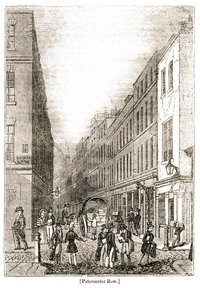 The center of London’s publishing trade since as early as the 1550s, Paternoster Row in the City of London may have originally started as the hub of book selling (Grant, 1839). Grant reckons that during the late Regency era (1810-1820) the average number of books published a year was between 500 and 600, with those numbers steadily climbing every year. Grant goes on to describe the activity in the houses along the Row:
The center of London’s publishing trade since as early as the 1550s, Paternoster Row in the City of London may have originally started as the hub of book selling (Grant, 1839). Grant reckons that during the late Regency era (1810-1820) the average number of books published a year was between 500 and 600, with those numbers steadily climbing every year. Grant goes on to describe the activity in the houses along the Row:
Many periodicals also originated or were sold from Paternoster Row:
Paternoster Row was said to be named from the text writers who use to live their scribbing at religious books and similar texts (Britton and Rees, 1896). There is also some association with rosary beads that were at one time sold along with other religious items.
Doubtless a fascinating, bustling place, Paternoster Row would have been a sight to behold particularly for a literary man. Its continued growth from the Regency to Victorian eras reflected an increasingly literate population as industrialization supported the need for more broad education.
Britton, J and T. Rees (1896). Reminiscences of literary London from 1779 to 1853. Harper: New York.
Grant, J (1839). Sketches of London. Carey and Hart: London.









